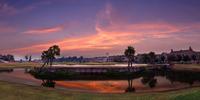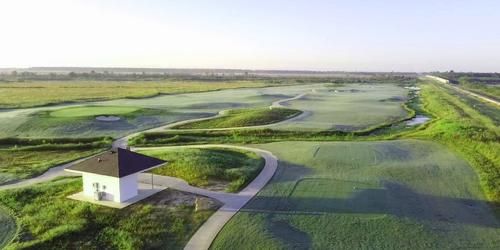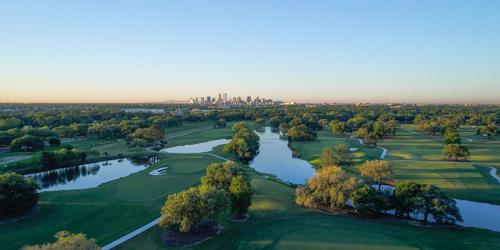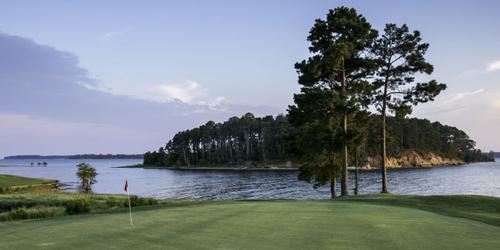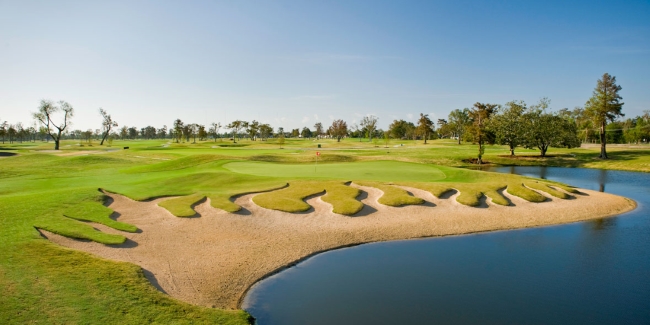
New Orleans golf courses are almost as much fun as Bourbon Street
By Steve Habel
NEW ORLEANS - When one thinks of New Orleans, it's usually for the decadence of Bourbon Street or the hundreds of world-renowned restaurants or the mighty Mississippi River or the arts district or the streetcars or... golf?
The Big Easy is not a "golf destination" per se, but the courses in the city and its suburbs are some of the best anywhere in the South and worth traveling to Louisiana's easternmost sectors to enjoy and experience.
I've taken a dozen trips to the Crescent City over the years and in those visits have been lucky enough to play many of the area's top public and private tracks. Some area great and the others are good, and there's no doubt that the golfer can find plenty of places to play within a half-hour of the French Quarter.
Two daily-fee courses, Lakewood Golf Club and 27-hole Stonebridge Golf Club - both across the Mississippi River on the West Bank in Gretna - have helped lead the resurgence of golf in the Big Easy. Each facility boasts playable routings and relies on plenty of twists and turns, but fewer trees than before Hurricane Katrina roared through the area in 2005, to spice up the relatively flat land in this part of Louisiana.
Also in Gretna is the finer-than-fine English Turn Golf and Country Club, a private course that can be played in conjunction with stays at selected New Orleans hotels. It's one of the must-plays on this trip.
Go west, young golfer!
Founded as Lakewood Country Club in 1961 and serving as the host of New Orleans' PGA Tour event 26 times, Lakewood Golf Club underwent a multi-million-dollar renovation with some cool features and - at 7,002 yards - a good test of golf.
Originally designed by Robert Bruce Harris, an adherent of the "garden school" of golf architecture, Lakewood was on the verge of bankruptcy when the New Orleans Firefighters Pension Fund purchased the property in May 2003 for $6 million.
The private club was closed and the facility opened to the public. There were grand plans for the site, including the development of an upscale resort that would include golf villas, a four-star luxury hotel and condominiums.
Those lavish ideas were sidetracked by the dual hurricanes, but the course - with a fabulous new set of holes designed by Ron Garl - preserved the character of the original layout while upgrading it with creative bunkering, modernized fairway contouring and updated tee boxes and greens.
Lakewood is nestled among beautiful Louisiana cypress and oak trees. Garl's work features distinctive bunkers, including four red-sand-filled "flaming" hazards (three of which are on the 444-yard par-4 18th hole), one formed to resemble a Fleur de lis and another in the shape of a fireman's seal, all tributes to Louisiana and the firemen-owners of the course.
The course itself is commendable, especially it's wonderful collection of par-4s (handicap Nos. 1-4 are two-shotters, each at least 439 yards in length) and short par-3s (none longer than 189 yards).
Lakewood's final two holes are noteworthy - one for water and the other for fire, or at least the reference of it. The 17th is a 160-yard par-3 played over a pond to a green surrounded by water on three sides. The par-4 closer involves an into-the-wind 444 yards and sports three of Garl's flaming bunkers and a Lewis woodcarving of an angel hovering over a fireman carrying a baby.
Just up the road is Stonebridge Golf Club, which features 100-plus bunkers that are strategically strewn about and water in the form of 28 lakes, ponds, canals and bayous. With those challenges, it's great that the course occupies mostly flat terrain and is very open on the interior, with a few trees to deal with and that forced carries are also at a minimum.
Stonebridge Golf Club opened in 1984 and was renovated by John Robinson 20 years later. The par-72 course stretches 7,031 yards, where it carries a rating of 74.3 and a 135 Slope.
The massive 467-yard, par-4 fourth has eight bunkers in various spots both sides of the fairway, and the 462-yard eighth has two deep 100-yard-long sand hazards on either side.
The back nine's stoutest tests are its par-4s, including the 422-yard 13th and the 470-yard 15th. No. 14 is a short but stern par-3 over water. Players will also be challenged by the 590-yard, par-5 10th.
It's "other nine," which plays to a par of 35 and at 3,047 yards, compliments the main course but is more than an executive track.
Some of the toughest holes on Nos. 19-27 include its two par-5s, the 542-yard 23rd (which turns left to right and features a pond that must be carried on the approach), and the 521-yard 26th, a straightaway hole with four bunkers guarding the green.
With six sets of tees, holes named after jazz greats Louis Armstrong, Pete Fountain and Al Hirt and plenty of chances to see reptiles and waterfowl, Stonebridge characterizes the uniqueness of the New Orleans golf experience.
History abounds at English Turn
The golf course at English Turn was designed by Jack Nicklaus and was designed to provide as exquisite a visual experience as it is a great round of golf. Nicklaus fashioned gallery berms and spectator mounds all along the course that were built specifically for the USF&G Classic (now the Zurich Classic), but the Golden Bear also knew the track needed to be playable for golfers of all ability levels the other 50 weeks of the year and made it so.
At English Turn, Nicklaus created 18 unique, championship holes on a course completely surrounded by the Norman Canal. Despite being the centerpiece of an exclusive neighborhood the routing was not designed to divide residential areas - each hole here challenges players with its own personality.
Giant sand and waste bunkers guard many holes, and numerous grass depressions line the sculptured fairways. The smallish greens are notoriously tiered and undulating and some are wickedly shallow, challenging, yet fair, for the club member and pros alike.
Nicklaus took into consideration the unique drainage issues that are associated with golf in New Orleans when designing English Turn and it shows. Conditions are flawless and consistent, and the par-72, 7,078-yard track - now considered short for a championship course - can be more than a handful when the wind is up (and it always seems to be.) English Turn carries a rating of 74.6 and a slope of 140 from its back set of four tees.
The course is designed to allow the golfer to ease into a round, as the 539-yard, par-5 second (ranked as the No. 18 handicap hole) plays shorter than it's carded and can be attacked as long as the deep bunker that runs along the majority of the fairway can be avoided.
The meat of the golf experience at English Turn is in its par-4 holes, five of which play at 430 yards or more from the back tees. The front-nine sports the 445-yard fifth (with extensive mounding to the left of the fairway) and the bunker-laden 446-yard seventh, both character-builders requiring the high fade (for right handers) that Nicklaus preferred to hit.
On the back-nine has three of the long two-shotters - the 467-yard 14th, the 430-yard 16th and the daunting 471-yard closing hole, which was consistently rated one of the most challenging on the PGA Tour when it was held at English Turn. That trio and the 540-yard par-5 15th, which ends on an island green set in a pond to the right of the landing area, make up the toughest stretch at English Turn.
Leave it to Nicklaus to make sure the holes that would have received the bulk of the airtime during a telecasted Tour event would be the course's most spectacular.
The player will be amazed at how small some of the greens are at English Turn, none more so than the wide, but maddening shallow, putting surface on the 376-yard par-4 13th. Golfers will need to hit a softly lofted shot from the fairway to keep any ball on the green here.
The grounds that make up the course and the community at English Turn are rich in history. During the spring of 1699, war raged between England and France. The exploration and colonization of the Mississippi River (and the plundering of the river's untold riches) were prime concerns for both countries. France had established a small colony along the Mississippi near New Orleans, and England, anxious to control the river, sent a warship to invade the French settlement.
Jean-Baptiste Le Moyne de Bienville, lieutenant of that settlement in the Louisiana colony that would become New Orleans, understood the impact of an invasion by the English. He dispatched a small convoy to the British warship anchored to the south of New Orleans. Bienville, approaching the English captain, warned him to depart immediately or face a large-scale military battle. The English turned the warship around and returned to England.
Bienville had bluffed the English captain - the French "armada" consisted of only two small canoes with five brave Frenchmen. To this day, the grand bend in the Mississippi downriver from Old New Orleans is called "English Turn."
Unlike Bienville's armada, the golf experience at English Turn Golf & Country Club is genuine and large. The course makes golfers execute all their shots to score well and is a real challenge but fun to play.
English Turn has never wavered about being serious about its golf. The course's highly manicured greens, meandering lakes and magnificent plantation-style clubhouse make a round at English Turn a must-play if you are in the region. The club is located just eight miles from New Orleans' Central Business District.
Plenty of fun to be had off the course as well
No one needs to be told that New Orleans is a place to have as much of a good time as you can bite off and chew but man cannot golf and party all 24 hours of the day - there needs to be a place to rest and sleep off some of those hurricanes and quart-size beers and one has to eat to fuel up for the next day's round.
On this trip we were fortunate enough to stay at the historic Bourbon Orleans Hotel, a grand Southern hotel with a haunting past. The inn is set on Orleans Street between the party-centric Bourbon Street and upscale, art-gallery-clad Royal Street and offers visitors the best of both worlds. It's home to a delicious Creole restaurant, a signature cocktail (that's the Sloe Gin Fizz) in its popular bar and 218 attractive, elegant rooms.
The Bourbon Orleans also offers an intriguing history (ask about the resident ghost) and a stunning outdoor saltwater pool.
Dinner on our one free night was at the Desire Oyster Bar on Bourbon Street, which offers diners one of the most authentic culinary experiences in New Orleans.
From the quintessential New Orleans "characters" who shuck the famous chargrilled oysters on the half shell and more-to an extensive new menu that includes classics like the famous "Creole Trio" (jambalaya, red beans and rice and gumbo), it's the perfect setting to enjoy a great meal in the center of all the action of the French Quarter.
More information: NewOrleansCVB.com
Revised: 03/21/2016 - Article Viewed 32,054 Times
About: Steve Habel
![]() Steve Habel is a contributing editor for GolfTrips and its associated websites. A 26-year industry veteran, he regularly contributes to various regional, national and international golf publications and has played and written about more than 1,600 golf courses around the world.
Steve Habel is a contributing editor for GolfTrips and its associated websites. A 26-year industry veteran, he regularly contributes to various regional, national and international golf publications and has played and written about more than 1,600 golf courses around the world.
Habel is also senior editor for Horns Illustrated magazine, a publication focusing on University of Texas sports, as well the San Antonio Spurs beat writer for The Sports Xchange. He is a correspondent for the Austin American-Statesman and frequently files stories and features for The Associated Press and Preferred Lifestyle magazine.
Habel, who lives in the Austin, Texas area, has worked media coordinator for World Golf Hall of Fame player and golf architect Tom Kite as well as for renowned golf architects Roy Bechtol and Jeffrey D. Brauer.
He is a member of the Golf Writers Association of America, the Texas Golf Writers Association and the Football Writers Association of America.





